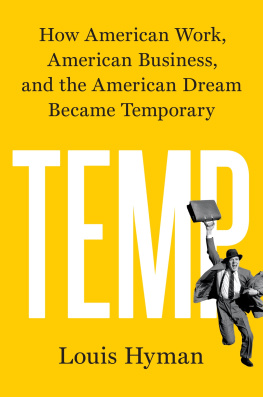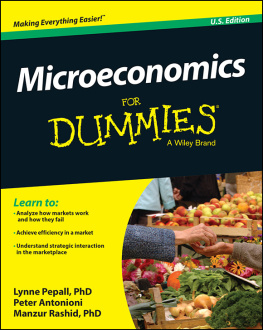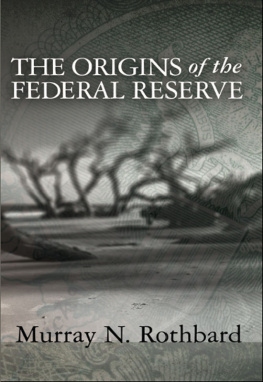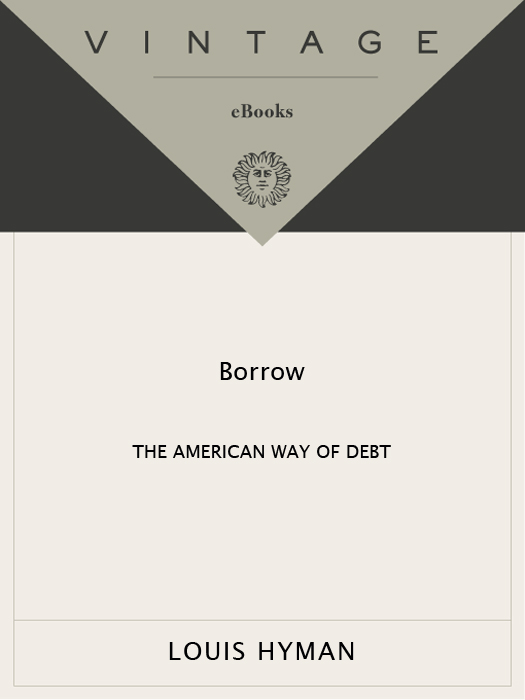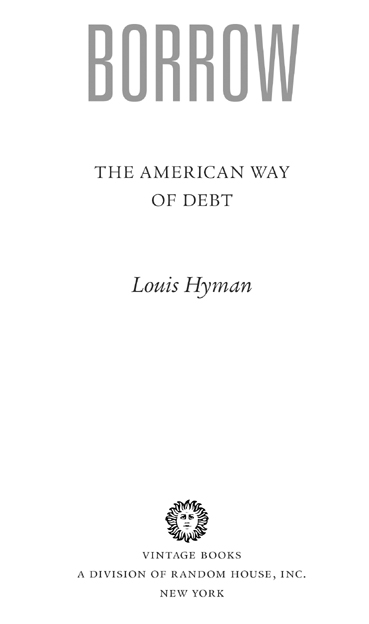Louis Hyman
BORROW
Louis Hyman attended Columbia University, where he received a BA in history and mathematics. A former Fulbright scholar and a consultant at McKinsey & Co., he received his PhD in American history in 2007 from Harvard University. He is currently an assistant professor in Cornell Universitys School of Industrial and Labor Relations, where he teaches history.
Also by Louis Hyman
Debtor Nation: The History of America in Red Ink
A VINTAGE BOOKS ORIGINAL, JANUARY 2012
Copyright 2012 by Louis Hyman
All rights reserved. Published in the United States by Vintage Books,
a division of Random House, Inc., New York,
and in Canada by Random House of Canada Limited, Toronto.
Vintage and colophon are registered trademarks of Random House, Inc.
A portion of this work first appeared in slightly different form in
The Wilson Quarterly, Winter 2012.
Library of Congress Cataloging-in-Publication Data
Hyman, Louis, 1977
Borrow : the American way of debt / Louis Hyman.
p. cm.
eISBN: 978-0-307-74490-6
1. Consumer creditUnited StatesHistory. 2. DebtUnited States
History. 3. Loans, PersonalUnited StatesHistory. 4. United States
Economic conditions. 5. United StatesEconomic policy. I. Title.
HG3756.U54H95 2012
332.743dc23
2011041427
www.vintagebooks.com
v3.1
For Patty
CONTENTS
INTRODUCTION
Everything Old Is New Again
CHAPTER ONE
When Personal Debt Was Really Business Debt
CHAPTER TWO
Everybody Paid Cash for the Model T
CHAPTER THREE
Fannie Mae Can Save America
CHAPTER FOUR
How I Learned to Stop Worrying and Love the Debt
CHAPTER FIVE
Discounted Goods and Distributed Credit
CHAPTER SIX
Bringing Good Things to Life
CHAPTER SEVEN
If Only the Gnomes Had Known
CHAPTER EIGHT
The House of Credit Cards
CONCLUSION
Turning the Magic of Borrowing into the Reality of Prosperity
INTRODUCTION
EVERYTHING OLD
IS NEW AGAIN
Dick and Jane Smith met shortly after they had both moved to the city, coming upon each other in the park on a sunny Sunday afternoon. Romantic sparks flew, declarations of love were exchanged, rings and vows followedand then they began their search for a home of their own, where they would start their new life together.
Dick hadnt gone to college, but he had recently found work in a new industry whose products were sweeping the country. The companys IPO a few years back had been one of the most successful in history and he was going to help manufacture the killer product that, as one of his executives had said in his firms annual report, had given us all something worth working for. Dick and Jane, like the rest of the country, were caught up in the heady optimism of what newspaper pundits said was a New Era.
Flush with love and short on cash, the Smiths went to their local bank to find out if they could get a mortgage. The home that they wanted was expensive, like all houses those days, but the Smiths knew that houses were a good investment. Prices had gone through the roof in the past few years, and real estate was always a sure thing. You cant make more land! Jane remembered her father always saying.
At the bank, the Smiths met with a well-dressed mortgage officer. Looking over the application, the mortgage officer asked them far fewer questions than they had expected: how long had Dick had his job, how long had they lived at their current address, how much did he make? After a few calculations, the mortgage officer somberly informed them that an amortized mortgageone in which they repaid against both interest and principal every monthwould not get them the house they wanted. Dicks income was just not enough to cover it.
But the Smiths didnt have to worry. The bank offered another, better option that most smart people were using those days: an interest-only balloon mortgage. With a balloon mortgage, Dick and Jane could buy the house immediately, sleeping soundly with the knowledge that their household income had nowhere to go but up, right alongside real estate values. When the time to pay off the principal finally came a few years down the road, they could simply refinance with a new loan that was just as affordable as the first. Why slowly pay down the principal when they would probably just sell it for more in a few years, anyhow? Like the mortgage officer had said, it was the smart thing to do.
In fact, they would have to refinance since the loan was for only four years, but that wouldnt be a problem at all. The mortgage officer explained, in confident tones, that refinancing would never again be a problem because banks had started issuing mortgage-backed securities to finance their customers. Investors were always looking for a good deal, and real estate was a sure thing.
Four years! Dick would almost certainly move up in his burgeoning high-tech industry in that time. Jane already envisioned a bigger space, the envy of her sisters. The couple looked at each other knowingly, trusting in the guidance of the mortgage officer, and signed the papers he offered them.
Dick and Jane thought they couldnt go wrong. They were in the middle of one of the greatest housing booms in U.S. history, with home values seeming to double every time they turned around. Developers couldnt build houses fast enough. Smart buyers would act fast, they thought, before home prices rose even more. There was no risk, only reward.
Dick and Jane moved into their house, and Dick went to work. Within the year, orders began to slow down. He didnt lose his job, but his overtime was cut. Then it hit. At first the big stock market crash didnt affect him, but it soon spilled over into the real world. Everywhere confidence in the economy slid. The newspaper stopped using New Era except in derision. Then, just as he had to refinance his house, everything fell apart.
House values began to plummet; balloon mortgages became impossible to refinance; foreclosures in their neighborhood became, seemingly overnight, more common than rare. Like the stock speculators who had borrowed on the margin, millions of Americans just like Dick and Jane were living on the edge of their household incomes so that they could own their homes. They would be fine, thoughwouldnt they?because their mortgage fit their budget. All too late, Dick and Jane realized that they were speculating just like those hucksters on Wall Street.
Dick walked into the savings and loan only to find that his mortgage officer had been sacked. His replacement, considerably less friendly than his predecessor, told him in no uncertain terms that he had to come up with the principal or he would be foreclosed on. Dick sputtered. He had done what the man in the suit had told him. How had this happened? Before turning his back and returning to his work, the new guy at the bank told Dick that investors no longer wanted to buy real estate bonds. The well was dry. Without mortgage funds to lend, the bank had to collect.
When the bank repossessed their dream house, Dick and Jane didnt have even the most basic of personal luxuriesno iPod, no tablet, not even a hand-me-down smartphone. Desperate as they were, they literally couldnt even give those things up in one last fruitless effort to save their home. After all, none of them would be invented until the next century.




